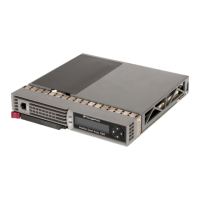HP StorageWorks 1000/1500 Modular Smart Array Command Line Interface user guide 25
LUN-related commands
The following commands are used to physically locate specific hard drives in a LUN as well as create,
delete, and modify storage LUNs.
• Flashing LEDs/locating hard drives
• Creating LUNs
• Assigning a name or ID to a LUN
• Adding a spare to an existing LUN
• Deleting LUNs
• Deleting spares
• Recognizing a failed unit
• Expanding an array
• Extending a LUN
• Migrating a LUN to a different RAID level
• Changing the cache setting for a LUN
• Setting the preferred path for a LUN
• Enabling/disabling automatic path switching
Flashing LEDs/locating hard drives
A variety of commands are available for physically locating specific hard drives. You can precisely locate
all drives attached to the MSA, all drives in an exact storage enclosure, all drives on a specific SCSI bus, all
drives in a specific LUN, or a particular hard drive.
When these commands are executed, the LEDs of the requested drives will blink. These LEDs are visible
from the front of the MSA and its attached storage enclosures.
NOTE: If a time limit is not included with the locate command, the LEDs will blink for 30 seconds.
The basic command verb is locate, but a variety of command nouns and command options are
available to customize the request.
Basic command
locate [all] [box x] [bus x] [cancel] [disk diskxxx] [disk diskxxx-diskyyy]
[time=t] [unit x]
Command options
all—all drives connected to the MSA storage subsystem will be located.
box x—the number of the storage enclosure whose disks you want to locate. This option applies only
to the MSA1000.
1=the MSA1000 drive shelf
2=the storage enclosure attached to SCSI port A
3=the storage enclosure attached to SCSI port B
bus x—the number of the bus whose disks you want to locate. This option applies only to the
MSA1000.
cancel—immediately turns off all location LEDs.
disk diskxxx—a specific drive to locate. Disks are identified by box number and bay number.
disk diskxxx-diskyyy—a range of drives to locate. Disks are identified by box number and bay
number.
time=t—(optional) the length of time to flash the LEDs, where t represents the number of seconds. This
option must be preceded by another option such as all.
unit x—the number of the LUN whose disks you want to locate.

